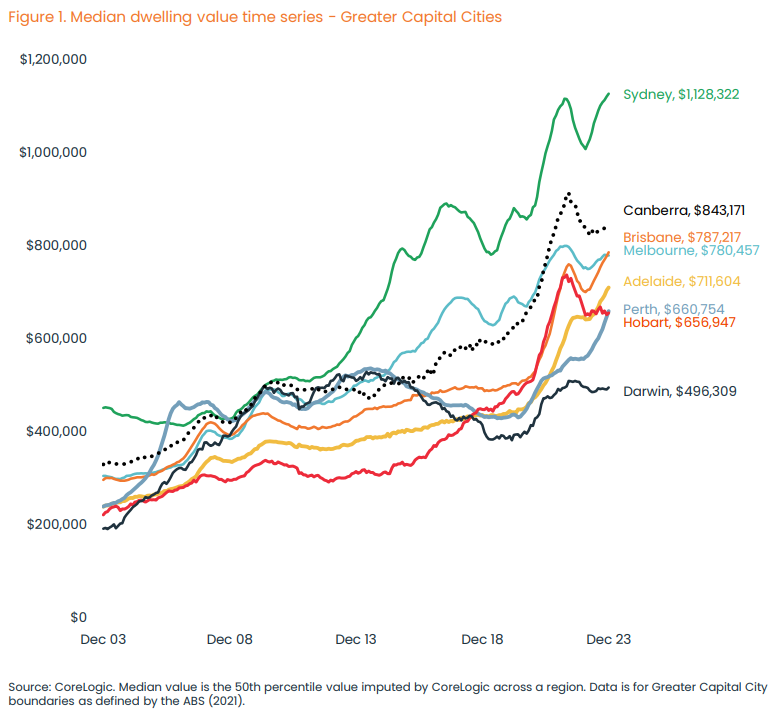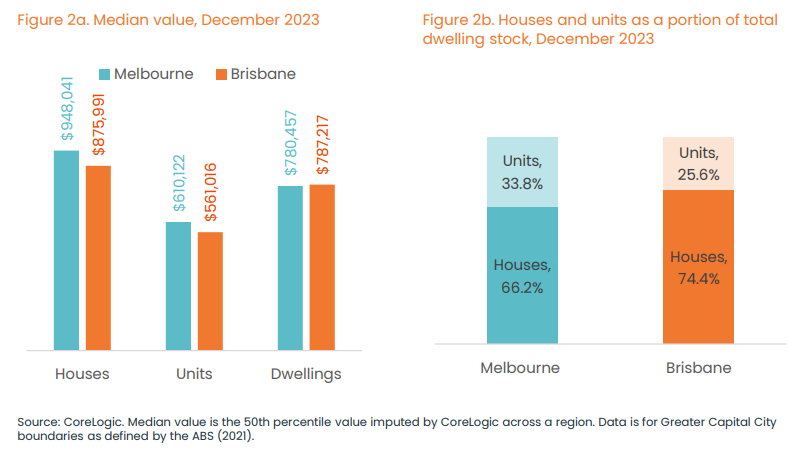Nothing a little bit of northern migration and the Olympics couldn’t fix. CoreLogic with the report.
Brisbane homes have seen extraordinary capital growth in the past few years, rising 50.2% since the onset of the pandemic in March 2020.
The city’s appeal amid an increase in remote work helped fuel strong population growth, increasing housing demand, driving down supply and making it a seller’s market.
At the end of last year, Brisbane reached a new milestone. The city now has the third-highest median dwelling value among the capitals, behind Sydney and Canberra.
In December, the Greater Brisbane median dwelling value was $787,000, surpassing Melbourne’s median value for the first time since July 2009 by around $7,000 (Figure 1).

So why has Brisbane surpassed Melbourne in the median dwelling value ranks?
Composition of housing stock. Despite recording a higher median dwelling value, Brisbane’s median house and unit values are still -$72,000 and -$49,000 below Melbourne’s medians respectively (Figure 2a).
The reason for this is that Melbourne has a higher share of units as a portion of the dwelling market.
CoreLogic estimates that units comprise 33.8% of Melbourne dwellings, compared to 25.6% of homes across Brisbane (Figure 2b).
Because units are generally lower value than detached houses, a higher portion of units brings down the median dwelling across all houses and units.
In the near term, this compositional difference might rebalance a little.
The latest building activity data from the ABS showed that as of June last year, there were 1.4 units under construction for every house in Victoria, compared to 1.6 units for every house across Queensland.
This implies there could be a slightly higher concentration of unit stock to come across Brisbane.
Brisbane booms against mild Melbourne upswing.
Since the onset of the pandemic in March 2020, Brisbane dwelling values rose 50.2% through to the end of last year.
Over the same period Melbourne values rose just 11.0% (Figure 3), which was the weakest increase of any capital city market.

This disparity in growth has seen Brisbane’s median dwelling value rise from -$187,000 below Melbourne’s median in March 2020, to $7,000 higher in December last year.
The reason for such varied capital growth outcomes may be partly due to lifestyle factors, where the appeal of South East Queensland rose through the pandemic.
The normalisation of remote work for many professionals made interstate migration to Queensland more feasible, while Melbourne’s extended lockdowns from March 2020 through to October 2021 may have prompted people to leave the city.
It’s pretty straightforward.
Melbourne is being transformed into a Third World city with its demographics determined by inflows of poor foreigners that live a dozen to the apartment.
On the other hand, Brisbane is on the receiving end of rich southern Aussies seeking a backyard.
Expect the price trend to continue.

